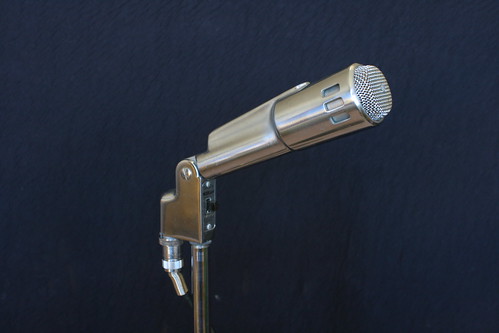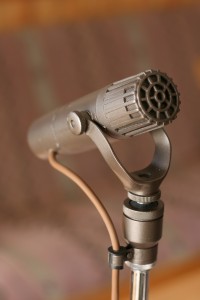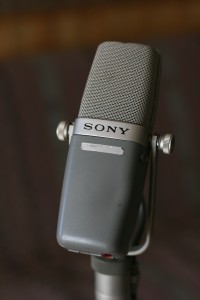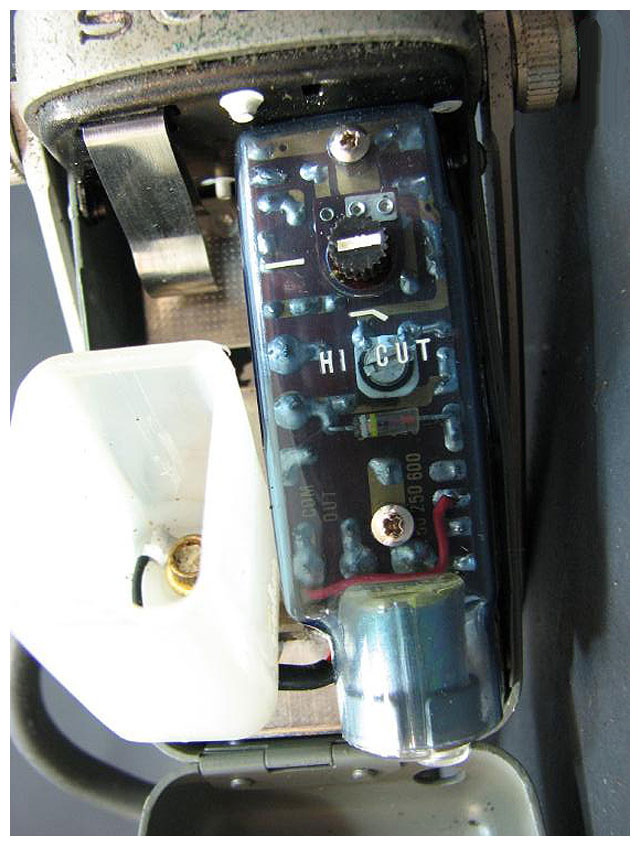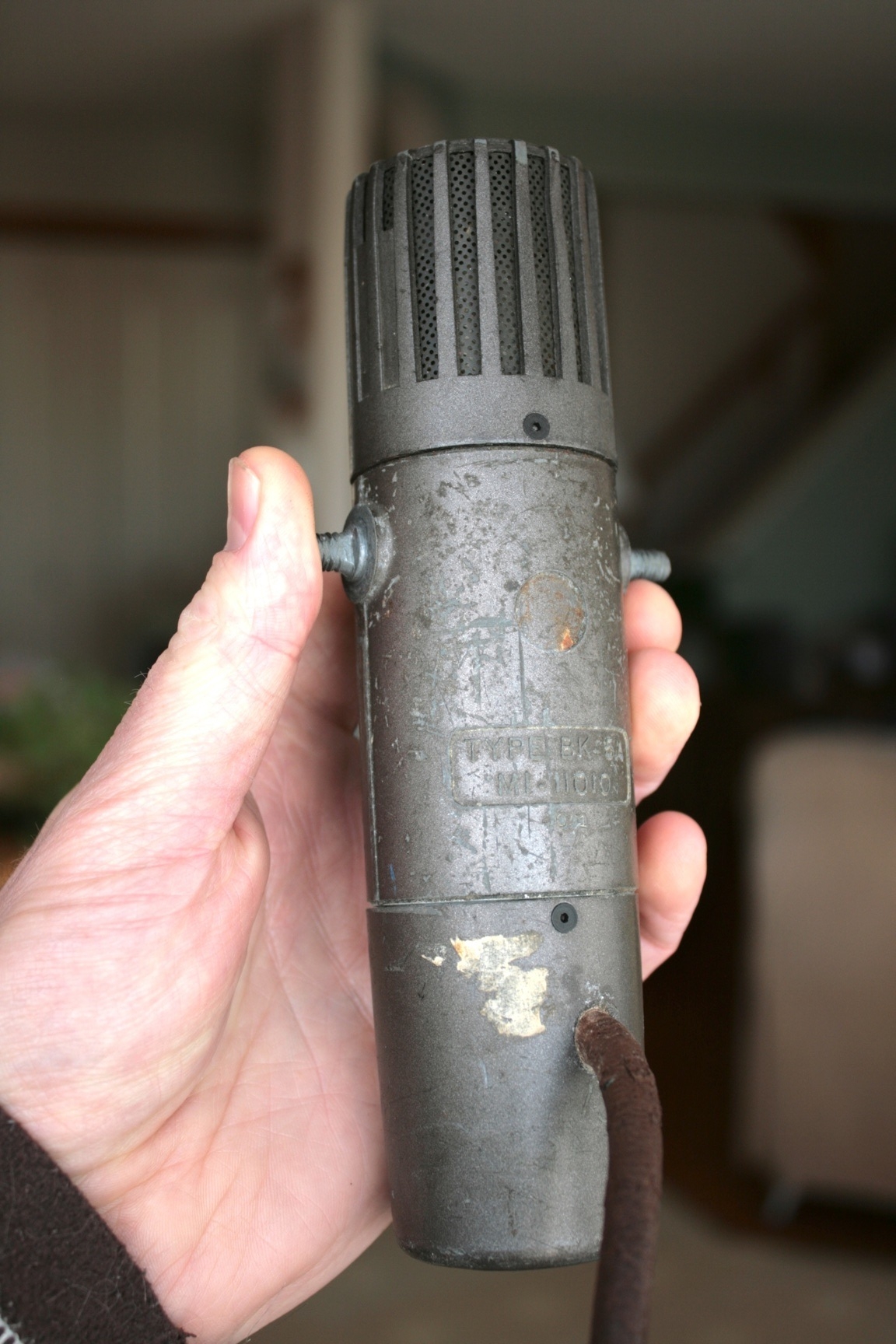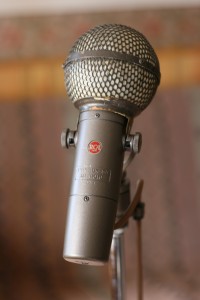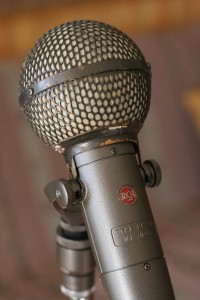Electro-Voice 664 Dynamic Microphone
I got this cool old microphone in for some minor repair. It's a classy-looking art-deco kind of mic from the 1950s and 60s, with a very durable chrome finish.
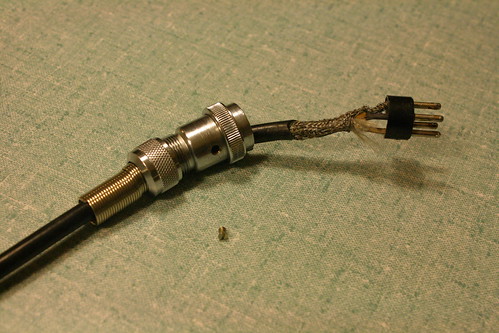
Electro-Voice Model 664 - four pin connector at the mic end.
This one is in really good condition, complete with a solid cable (I don't think it's the original). I soldered a modern XLR connector on the end. It appears they usually came with a 1/4" phone plug. It can be set for high impedance or low impedance (150 ohms) by swapping the white wire in the four-pin Amphenol connector at the mic end. It was originally set for high impedance, which is likely most suitable for plugging into a guitar amp. I tried the mic out that way, plugged into my Allen & Heath console, and it didn't sound very good. It was a little tinny (using my voice as a source), and there was significant noise being picked up. High impedance sources are much more susceptible to picking up electromagnetic interference.
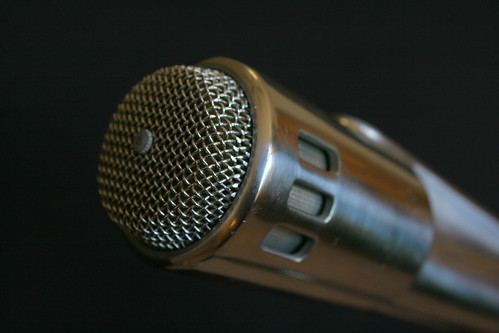
Electro-Voice Model 664 Dynamic Mic
So I swapped the white wire from pin 2 to pin 3 at the mic end. The instructions talk about pulling the "slip pin" out to effect this change, but this connector had the wire soldered into the pin. After the swap, it sounded way better, and the noise was gone. I pulled out a little 1 kHz and boosted about 120 Hz a little, and it sounded pretty good on voice. Looking at the frequency response, this mic really rolls off the low frequencies in order to reduce the proximity effect. The response curve from the data sheet shows 100 Hz to be 5 dB down compared to 1 kHz, so I guess I'm levelling that off a little.

There is more information on Recording Hacks, and some great pics and the engineering data sheet on Coutant's website. Read some background on the Variable-D design on ProSoundWeb and EV's website.
I've got a bunch of pics on my flickr. This is such a groovy looking mic, it's too bad I have to give it back to the owner!!
A Wired Article on Ribbon Mikes
This article just appeared in Wired. Here is a great quote: "We'll have bands come in and pick up that BK5 like it's coming out of the tomb of Tutankhamen," says Vanderslice, "Like it has this divine healing property. ..."
I have an RCA BK-5A ribbon mike in my studio and have used it on a number of things. Yeah, it sounds pretty good.
I guess I can now offer Divine Healing services! I better increase my rates!
Actually, Vanderslice continues: "... In the scheme of things, the content of the music, or the lyrics, or the sound of electric guitar or the amplifier, it is a very small percentage of what's going on."
Music?? Lyrics?? That stuff matters? Doh!! 😉
Ribbon Mike Restoration
Here's an interesting article about the guy who restored my RCA BK-5A:
More on the Bluegrass Mike Technique
Recently, I had the opportunity to use an Audio-Technica AT4050 large diaphragm, multi-pattern condenser microphone as a single-mike at a bluegrass concert. I switched it to cardioid and it sounded really great - probably my favourite so far. Everything was so clean and clear. The vocals (a group of women), and all of the instruments (guitar, mandolin, fiddle, autoharp, penny whistle) sounded perfectly natural. I had the upright bass plugged in which helped fill out the bottom end. It was noticeably missing when I tried turning off the bass channel. I used two matched Oktava MK-012 small diaphragm condensers for side mikes, and they worked great. I used them with hypercardioid capsules. The mandolin and one acoustic guitar used them for instrumental breaks.
In the past I have used:
AT3035 - it's a fairly cheap mike, but sounds pretty decent for the money.
Rode K2 tube mike - sounded really good with a variety of voices and instruments.
AKG 414 - also very good.
Rode NT1000 - pretty decent.
They all work pretty well, but they each have a slightly different characteristic.
Sony Condenser Mikes From The 1960s.
I have this old Sony condenser mike.
From the pictures and information I found on the web here, I thought it was a C-37-FET. I don't have the power supply that came with it, so I found circuit schematics to figure out how to hook up the five pin XLR connection. I tried reverse engineering the circuit in the mike, and found it's not quite like the circuit diagram in the C-37-FET Technical Manual (which is available on the above web site). Eventually I realized that it is in fact a C-38A (or B??), a 1969 update of the C-37 mikes! There isn't much info available on this mike - it seems quite rare - and I'm not sure all of the information I've found on the web is completely accurate. Apparently this mike has been used at Abbey Road studio to record the Beatles, and Herb Alpert's trumpet on A Taste of Honey:article here.
Update 2010.11.05: new information I have received indicates that my mike is almost, nearly, just about, absolutely for sure a C-38B.
I did get the mike working by building a simple five-pin to three pin XLR converter. The mike can be operated with a 9V battery inserted or an external 9V power supply. Both of these methods can be remotely switched. I suspect it also can run from phantom power since there is a centre tap off the transformer that feeds the powering circuit. But I need to verify that there is a voltage regulator that drops 48 VDC to 9VDC so the DC-DC converter doesn't get fried. The information I found on the web suggests the C-38B, made in 1971, was modified to be used with phantom power. I'm almost sure that this one is not a C-38B, because it seems the C-38B has a three-pin XLR connection, while mine has a five-pin. The guy I got this from has the exact same mike with the power supply and the storage box with the model number on it (C-38A). Turns out his is a C-38B - but the box is from a C-38A!
There a few differences between the C-37-FET and the C-38B. The switch on the C-37-FET can be set to BAT to check the condition of the battery. On the C-38B, the switch is mechanically blocked from going to that position. So don't bother trying (I did). The internal circuitry is somewhat different, but I haven't completely traced out the schematic yet. There are differences in the two internal switches (high cut and 8 dB pad) - see the pictures below. The C-37-FET pictured doesn't have a pad switch.
Below is the powering diagram from the C-37-FET Technical Manual, which also works with the C-38A/B. Option 1 uses the internal 9V battery, and the switch allows you to turn it off remotely. The switch on the mike has to be on. Option 2 uses the internal 9V battery and has the mike on any time the connector is connected and the switch on the mike is on. This is how I wired my connector gizmo. It seems option 3 is slightly wrong. The jumper between pins 1 and 5 is also necessary here (or connect pin 5 to the shield - same difference).

C-37-FET powering
Here is a summary of the information I have found on similar Sony mikes (I got this info from the internet and some sleuthing, so I'm not 100% sure of its accuracy. If you have any corrections please let me know.):
C-37A: A tube condenser mike introduced by Sony in 1958 intended to compete with the Neumann microphones. Because of the tube circuitry it requires a special external power supply.
C-37P: A FET version of the mike that can be powered with 48VDC to 54VDC phantom power.
C-37-FET: Made in about 1965, it's a version of the C-37A that uses a field effect transistor (FET). It can be powered with an internal 9V battery or an external 9VDC power supply. It has a five pin XLR connector for powering and remote switching.
C-38: I'm not too sure about this one, if it existed. It could be simply a re-labelling of the C-37-FET, or people just dropped the 'A' when referring to it. One source says that the C-38 and the C-37-FET are the same: the C-38 was sold in Japan and the C-37-FET was sold in the US. Update (2010.10.29): I found pictures and some brief information on the C38. It was built in 1965 and the windscreen design is quite different from the C-38A and B. It looks like the C-37-FET inside and out from the photos, but I have no documentation on the C38 to verify if the two are identical.
C-38A: An update of the C-37-FET, introduced in 1969 with a new windscreen design. It has a five pin XLR connector for powering and remote switching. Can be powered by an internal 9V battery or an external 9VDC power supply, and possibly phantom power (I will try to verify this). Update 2010.11.05: A service manual I have obtained (copyright 1980) for the US indicates that the C-37-FET and the C38A have the same internal circuitry. No phantom powering!
C-38B (1971): An update of the C-38A, introduced in 1971. I think it had a three five pin XLR connector (not sure - I have no documentation). Can be powered by an internal 9V battery or 24VDC to 54VDC phantom power.
C-38B (1977): A further update of the C-38B. According to a service manual I have found, it has a three pin XLR connector. It can be powered by an internal 9V battery or 24VDC to 54VDC phantom power.
C-38B (2003): Sony re-released the C-38B in 2003. Can be powered by an internal 9V battery or 24VDC to 48VDC phantom power.
If you have any information about any of these mikes, or corrections to the above, please send it to me, especially the C-38A and C-38B (original) since that information is quite rare. This blog entry has become a little messy with corrections, so I plan to write an updated entry with the most complete information I can find. Owner's manuals and schematics would be great. Thanks!
Edit: Apparently this mike is the classic Manzai mike in Japan (thanks ratite!!). See this.
Restored RCA BK-5A
The RCA BK-5A ribbon mike is back in my hands. Here is a before picture, followed by some after pics. The mike was sanded and repainted to the original colour. The ribbon was completely missing inside the mike (which is what I suspected - I couldn't find one when I took it apart), so Clarence cut a new one and installed it according to the original RCA specification (size, tension, etc.). He put on a new cable since the old one was cracking up. The little screws were mostly missing, and the ones that were there were stripped, so they were all replaced. I didn't have the original shock mount, so Clarence supplied a reproduction shock mount that looks like the original. This mount was pretty expensive, but what are you gonna do. He supplied the knurled knobs for the mount, but unfortunately the threads on the mike are kind of screwed up - somebody must have cranked on the wrong size thread. So I'm not sure how to fix that. I had the little RCA medallion and so that is glued back on. It looks pretty good, and now it's time to check how it sounds.
Read more on ribbon mikes here.
RCA BK-5A
A quick update ... my RCA BK-5A ribbon mike has been restored by Enak Microphone Repair, and is on its way back to me! It should arrive within a few days along with a repaired mount for my old Sony C37-FET condenser mike. I can't wait to try it out on a vuvuzela. Actually, the only reason I said vuvuzela is to see if I get more google hits. Vuvuzela ya later.
RCA BK-5A
By really dumb luck, I happened to get my hands on an RCA BK-5A, a classic old ribbon microphone from about 1955. A friend of mine had it stashed away in a closet for years and I told him I'd be happy to take it off his hands and get in working order again. It's in rough shape cosmetically and the ribbon is missing. From what I've heard about this mike it's going to be a great addition to the mike complement in my studio. Here is a link to some information: RCA BK-5A.
I found a few places that do restorations on ribbon mikes. They all seem to be pretty well regarded, but I decided to go with ENAK Microphone Repair. The guy there has apparently worked for RCA beginning about 1952, and has been doing high quality restorations for years. I look forward to getting it back and trying it out on vocals and various instruments. I'll put up some pictures of it in a later post, and perhaps some audio clips too.
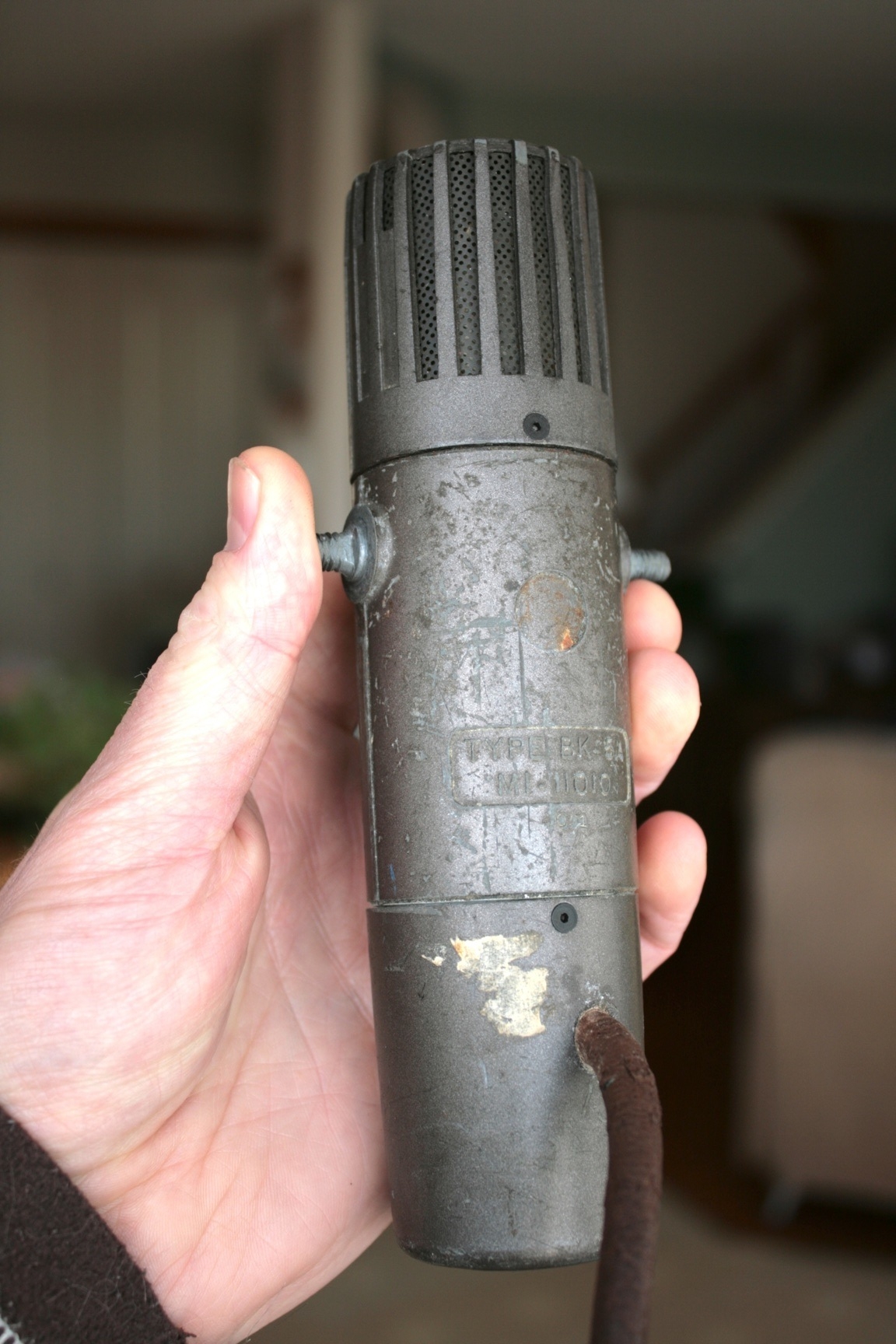
RCA BK-5A before restoration.

RCA BK-5A before restoration.
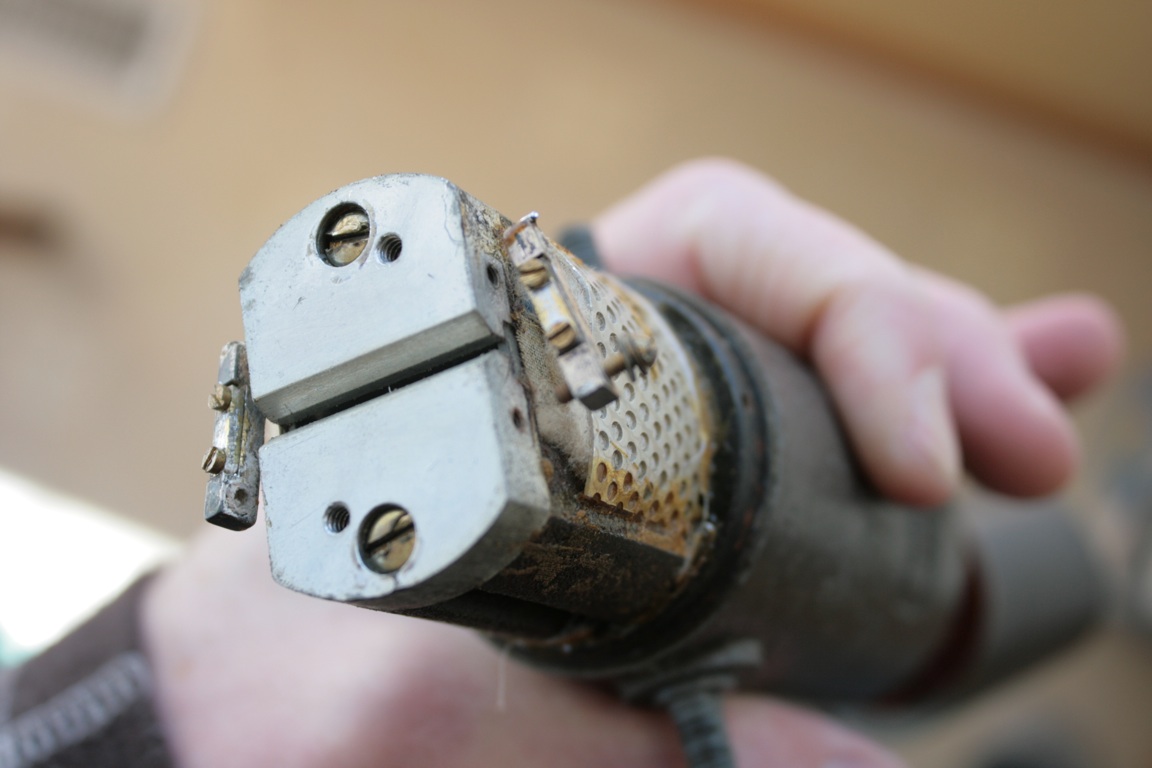
RCA BK-5A before restoration. It looks like the ribbon is missing.
The Traditional Bluegrass Microphone Technique: Part 1
This article of mine appeared in the Northern Bluegrass Circle Music Society's September newsletter. Part 2 will appear in January.
----
As most bluegrass aficionados are aware, many bluegrass and olde tyme musicians prefer the single mike technique for sound reinforcement. This technique can work quite well, but musicians need to understand how to work the mike properly in order to achieve the best sound. With one mike, and therefore one channel in operation at the mixing board, the sound person can do little to modify the sound - it's up to the musicians to achieve a good blend of instruments and voices. This can be difficult since the musicians can't hear exactly what the audience is hearing. The main performing advantages of the single mike technique are: the players get close together so they can hear and blend voices and instruments well, and it looks really cool as the musicians whiz around taking turns singing and playing instrumental breaks. This two-part article is intended to help people understand a little more about this technique. Part 1 talks briefly about the history and some technical details about microphones, and Part 2 will discuss proper microphone technique.
Part 1: History and Technical Stuff
Legend has it that way back before most of us were born, there weren't no iPods and there weren't no 'lektricity. Most music venues were designed with good acoustics, performances were small, and musicians knew how to project their sound acoustically. The arrival of newfangled technology: radio broadcast and sound reinforcement in the 1920s, allowed performers to be heard by much larger audiences. The earliest sound systems were simple, using a single omnidirectional or figure eight microphone with one amplifier channel to pick up an entire band. Musicians adapted, moving around the mike as necessary. As it turns out, much of country and bluegrass music was developing at this particular time. Although multiple channels are now easily and cheaply available, traditionalists prefer to use a single mike.
The Microphone
The term "omni" microphone is often misused. Omnidirectional microphones pick up sound equally all around the mike, but this is not very good since the band usually clusters on one side of the mike facing the audience. Omni mikes would pick up the audience side also, and suffer very badly from feedback problems. Therefore, most mikes used in live situations today are directional, having a "cardioid" pickup pattern. They generally pick up sound within about a 120 degree range on one side of the mike, and reject sound on the other side. Some mikes can be switched between cardioid, figure eight, and omni pickup patterns. Fig. 1 shows cardioid, figure eight and omni polar patterns. The polar pattern shows the level of pickup as you move around the mike. For example, the cardioid polar plot shows higher pickup at the front of the mike, lower pickup off to the sides, and almost no pickup at the back of the mike.
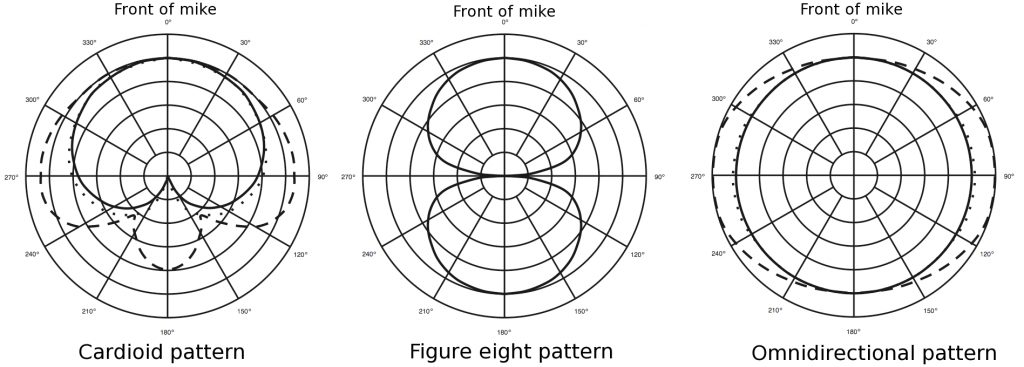
Figure 1: Cardioid, figure eight, and omnidirectional mike patterns. The solid line indicates the pickup “zone.”
Popular mikes in the bluegrass world are the Audio-Technica AT4033 and the Shure KSM32/44. These are high-quality, high-sensitivity, large-diaphragm condenser mikes. They have very clear sound, but they do not have quite the same sound of the RCA 44A and 77B ribbon mikes that were often used at the Grand Ole Opry, WSM radio, and in early recordings. Fig. 2 shows the old-timer ribbon mikes, the modern AT4033 condenser mike, and the Shure SM57, a very common dynamic mike.
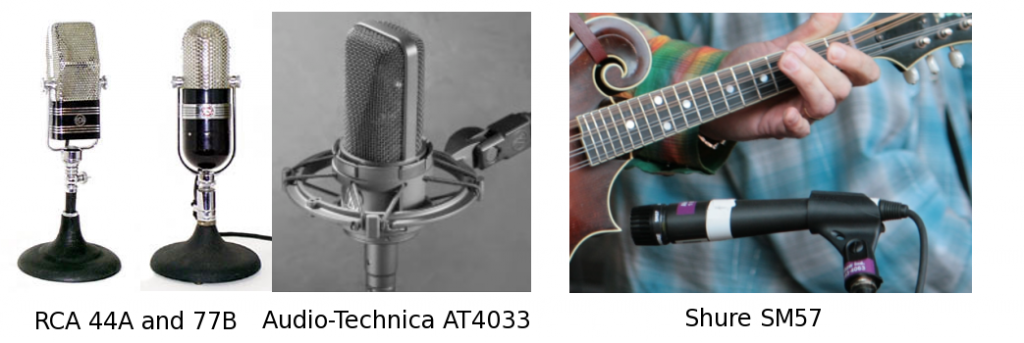
Figure 2: RCA 44A and 77B (ribbon mikes), the modern AT4033 (condenser) with shockmount, and the Shure SM57 (dynamic)
Dynamic, condenser, or ribbon mike? There's too much techie stuff required to explain the differences fully, but here is a summary. Dynamic mikes are very cheap, and immune to abuse (dropping them, swinging them through the air) and thus have become very popular live mikes. Condenser and ribbon mikes are generally more expensive (although that has changed a lot recently), have much better sound, and are susceptible to damage. Also, condensers require "phantom power" (48 volt power sent from the mixing board) while dynamics and ribbons do not. Ribbons are the most expensive and the most delicate, so usually large-diaphragm cardioid (directional) condenser mikes are favoured for live sound. The condenser diaphragm is the part that converts the sound to an electrical signal. A large diaphragm gives better low end response, but sometimes this is at the expense of high frequency detail.
Microphone Characteristics
You probably already know that the closer you get to a mike, the louder it picks up. So you need to be fairly close to be heard. What you may not realize, is that proximity to the mike also affects the tone of the sound. Generally, the best sound is directly in front of the mike and about six to eighteen inches away from the mike. When you get too close, the mike starts to sound really boomy (this is called the proximity effect, and the amount varies from one microphone to another), and it can pick up "plosives" like "p," "b," etc., and that can sound really bad amplified. You may also get distortion due to the high sensitivity, or you can suddenly get too loud and wake up the sound guy (and that's never a good thing). If you're too far from the mike, the sound gets really thin and tinny sounding, and the mike picks up more echoey room sound relative to the direct sound. Moving from the centre of the mike off to the side also changes the tonal quality somewhat. Mikes pick up footstomps on the stage, wind blowing through the mike's grill, and the entire acoustic space the band is in (not to mention DTTW's bottles tinkling, and any mumbling band members). Mikes should be mounted in a shock mount (that cage thing), and at outdoor festivals it's a good idea to use a windscreen. The quality of the acoustic surroundings is an often overlooked part of the sound. If the stage area is boxy and echoey sounding, that's what will get into the mike and amplified, and there will be big problems with feedback. The single mike technique is especially difficult to use in a bad acoustic space.
That's about enough for this instalment. Please tune in next time when I discuss microphone technique.
by Kevin Jacobson (www.cavemusic.ca)
Memeza Africa – Upcoming Shows
Memeza Africa's really big show is tomorrow! Friday, May 29th at the fabulous Winspear Centre in Edmonton, Alberta, Canada!
More shows are coming up in the next few days in Alberta and Saskatchewan. Numerous shows in Alberta and BC have been sold out, so get your tickets now.
May 29, 2009
Concert in Support of Edzimkulu A society for Children of Aids
Winspear Theatre
Edmonton, Alberta
Winspear Box Office
780 428 1414
1 800 563 5081
www.winspearcentre.com
May 30, 2009 7:30p.m.
Vermilion, Alberta
Lakeland College
Tickets at Vermilion Stationery
4913-50 Ave
780-853-2979
vermilionstationery@gmail.com
June 1, 2009
Broadway Theatre
715 Broadway Avenue
Saskatoon, Saskatchewan
www.broadwaytheatre.ca
June 2, 2009
Ulmer Chev Stage
Vic Juba Theatre
Lloydminster, Alberta
www.vicjubatheatre.ca
www.memezaafrica.org
www.flickr.com/photos/cavemusic/sets/72157616720118734/show/
